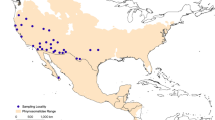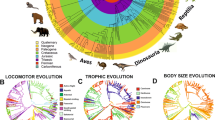Abstract
Despite nearly 200 years of scientific collecting and study, none of the extinct, bipedal, predatory, theropod dinosaurs have been reliably shown to exceed 12 m in length. Using digital 3D models of theropods with lengths spanning 80 cm to 12 m, their body masses were found to scale to the 3.5 power of body lengths. The lateral area of the pelvis and the cross-sectional area of the tail base of these animals corresponds to the cross-sectional areas of key muscle groups important for balance and locomotion, and both scale to the 2.4 power of body length. Body accelerations in the lateral and forward directions are, using F = ma, given by dividing muscle area (force proxy) by body mass. Plotting these acceleration estimates against body length shows them to decrease exponentially. The largest theropods with body lengths of 10–12 m have less than 10% of the acceleration capacity of the smaller forms. The distinct lack of fossil remains of theropods demonstrably longer than 12 m suggests that the theropod body plan had an upper size limit based on a minimum acceleration threshold. Rotational inertia of the theropod body was found to be proportional to body length raised to the 5.5 power, and with increasing length, the capacity for agility would rapidly diminish. The tight relationship between theropod pelvic area and body length allows for the estimation of body lengths of specimens lacking complete axial skeletons, and this is done for four, large, well-preserved pelves.




Similar content being viewed by others
References
Bates KT, Falkingham PL (2012) Estimating maximum bite performance in Tyrannosaurus rex using multi-body dynamics. Biol Let 8:660–664
Bonaparte JF, Novas FE, Coria RA (1990) Carnotaurus sastrei Bonaparte, the lightly built, horned carnosaur from the Middle Cretaceous of Patagonia, Natural History Museum of Los Angeles County. Contrib Sci 416:1–41
Brochu CR (2003) Osteology of Tyrannosaurus rex: insights from a nearly complete skeleton and high-resolution computed tomographic analysis of the skull. Soc Verteb Paleontol Mem 7:1–138
Buckland W (1824) Notice on the Megalosaurus or great Fossil Lizard of Stonesfield. Trans Geol Soc London 1(2):390–396
Canale JI, Apesteguia S, Gallina PA, Mitchell J, Smith ND, Cullen TM, Shinya A, Haluza A, Gianechini FA, Makovicky PJ (2022) New giant carnivorous dinosaur reveals convergent evolutionary trends in theropod arm reduction. Curr Biol 32:1–8
Chure DJ (1995) A reassessment of the gigantic theropod Saurophagus maximus from the Morrison Formation (Upper Jurassic) of Oklahoma, USA", in Sixth Symposium on Mesozoic Terrestrial Ecosystems and Biota, Short Papers. A. Sun, Y. Wang, Eds. Bei**g: China Ocean Press: 103–106
Conrad JL (2018) A new lizard (Squamata) was the last meal of Compsognathus(Theropoda: Dinosauria) and is a holotype in a holotype. Zool J Linn Soc 183:584–634
Coria RA, Currie PJ (2006) A new carcharodontosaurid (Dinosauria, Theropoda) from the Upper Cretaceous of Argentina". Geodiversitas 28(1):71–118
Coria RA, Salgado L (1995) A new giant carnivorous dinosaur from the Cretaceous of Patagonia. Nature 377(6546):224–226
Currie PJ (1997) Theropods. In: Farlow JO, Brett-Surman MK (eds) The Complete Dinosaur. Indiana University Press, Indianapolis, pp 216–233
Currie PJ, Carpenter K (2000) A new specimen of Acrocanthosaurus atokensis (Theropoda, Dinosauria) from the Lower Cretaceous Antlers Formation (Lower Cretaceous, Aptian) of Oklahoma, USA. Geodiversitas 22(2):207–246
dos AnosCandeiro CR, Brusatte SL, Vidal L, da Costa Pereira PVLG (2018) Paleobiogeographic evolution and distribution of Carcharodontosauridae (Dinosauria, Theropoda) during the middle Cretaceous of North Africa. Papéis Avulsos De Zoologia 58:e20185829
Halliday D, Resnick R (1988) Rolling, torque and angular momentum. Fundamentals of Physics, 3rd edn. Wiley, New York, pp 256–272
Henderson DM (1999) Estimating the masses and centers of mass of extinct animals by 3-D mathematical slicing. Paleobiology 25(1):88–106
Henderson DM (2002) The eyes have it: the sizes, shapes, and orientations of theropod orbits as indicators of skull strength and bite force. J Vertebr Paleontol 22(4):766–778
Henderson DM (2006) Floating point: a computational study of buoyancy, equilibrium and gastroliths in plesiosaurs. Lethaia 39:227–244
Henderson DM (2010) Pterosaur body mass estimates from three-dimensional mathematical slicing. J Vertebr Paleontol 30(3):768–785
Henderson DM (2012) Engineering a dinosaur. In: Farlow JO, Brett-Surman MK (eds) The Complete Dinosaur, 2nd edn. Indiana University Press, Indianapolis, pp 637–665
Henderson DM (2018) A buoyancy, balance and stability challenge to the hypothesis of a semi-aquatic Spinosaurus Stromer, 1915 (Dinosauria: Theropoda). PeerJ 6(e5409):1–29
Henderson DM, Snively E (2004) Tyrannosaurus en pointe: allometry minimized rotational inertia of large carnivorous dinosaurs. Proc r Soc Lond B (suppl) 271:S57–S60
Hutchinson JR, Garcia M (2002) Tyrannosaurus was not a fast runner. Nature 415:1018–1021
Hutchinson JR, Gatesy SM (2000) Adductors, abductors, and the evolution of archosaur locomotion. Paleobiology 26(4):734–751
Hutchinson JR, Bates KT, Molnar J, Allen V, Makovicky PJ (2011) A computational analysis of limb and body dimensions in Tyrannosaurus rex with implications for locomotion, ontogeny and growth. PLoS ONE 6(10):1–20
Ibrahim N, Sereno PC, dal Sasso C, Maganuco S, Fabbri M, Martill DM, Zouhri S, Myhrvold N, Lurino DA (2014) Semiaquatic adaptations in a giant predatory dinosaur. Science 345(6262):1232–1236
Ibrahim N, Mananuco S, dal Sasso C, Fabbri M, Auditore M, Bindellini G, Martill DM, Zouhri S, Mattarelli DA, Unwin DM, Wiemann J, Bonadonna D, Amane A, Jakubczak J, Joger U, Lauder GV, Pierce SE (2020) Tail-propelled aquatic locomotion in a theropod dinosaur. Nature 581:67–70
Kellner AWA, Azevedo SAK, Machado EB, Carvalho LB, Henriques DDR (2011) A new dinosaur (Theropoda, Spinosauridae) from the Cretaceous (Cenomanian) Alcântara Formation, Cajual Island, Brazil. (PDF). An Acad Bras Ciências 83(1):99–108
Loewen MA, Irmis RB, Sertich JJW, Currie PJ, Sampson SD (2013) Tyrant dinosaur evolution tracks the rise and fall of Late Cretaceous oceans. PLoS ONE 8(11):1–14
Novas FE, de Valais S, Vickers-Rich P, Rich TH (2005) A large Cretaceous theropod from Patagonia, Argentina and the evolution of carcharodontosaurids. Naturwissenschaften 92(5):226–230
Ostrom JH (1978) The osteology of Compsognathuslongipes. Zitteliana 4:73–118
Paul G (1988) Predatory dinosaurs of the world. Simon and Schuster, New York, NY
Paul G (2016) The Princeton Field Guide to Dinosaurs, 2nd edn. Princeton University Press, Princeton NJ
Persons WSI, Currie PJ (2011) The tail of Tyrannosaurus: reassessing the size and locomotive importance of the M.caudifemoralis in non-avian theropods. Anat Rec 294:119–131
Porro LB, Holliday CM, Anapol F, Ontiveros LC, Ontiveros LT, Ross CF (2011) Free body analysis, beam mechanics, and finite element modeling of the mandible of Alligator mississippiensis. J Morphol 272:910–937
Rhodes MM, Henderson DM, Currie PJ (2021) Maniraptoran pelvic musculature highlights evolutionary patterns in theropod locomotion on the line to birds. PeerJ 9(10855):1–20
Schmidt-Nielsen K (1989) Scaling: why is animal size so important? Cambridge University Press, Cambridge
Sereno PC (1993) The pectoral girdle and forelimb of the basal theropod Herrerasaurusischigualastensis. J Vertebr Paleontol 13(4):425–450
Sereno PC, Beck AL, Dutheil D, Gado B, Larsson HCE, Lyon GH, M JD, Rauhut OWM, Sadlier RW, Sidor CA, Varrichio DJ, Wilson GP, Wilson JA (1998) A long-snouted predatory dinosaur from Africa and the evolution of spinosaurids. Sci 282:1298–1302
Taylor CR, Weibel ER (1981) Design of the mammalian respiratory system I Problem and Strategy. Respir Physiol 44:1–10
Welles SP (1984) Dilophosauruswetherilli (Dinosauria: Theropoda) osteology and comparison. Palaeontogr Abt A 185:85–180
Author information
Authors and Affiliations
Corresponding author
Ethics declarations
Conflict of interest
The author declares no competing interests.
Additional information
Communicated by: Robert R Reisz
Publisher's note
Springer Nature remains neutral with regard to jurisdictional claims in published maps and institutional affiliations.
Supplementary Information
Below is the link to the electronic supplementary material.
Rights and permissions
Springer Nature or its licensor (e.g. a society or other partner) holds exclusive rights to this article under a publishing agreement with the author(s) or other rightsholder(s); author self-archiving of the accepted manuscript version of this article is solely governed by the terms of such publishing agreement and applicable law.
About this article
Cite this article
Henderson, D.M. Growth constraints set an upper limit to theropod dinosaur body size. Sci Nat 110, 4 (2023). https://doi.org/10.1007/s00114-023-01832-1
Received:
Revised:
Accepted:
Published:
DOI: https://doi.org/10.1007/s00114-023-01832-1




